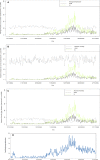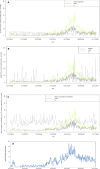Respiratory viral infections and effects of meteorological parameters and air pollution in adults with respiratory symptoms admitted to the emergency room
- PMID: 24034701
- PMCID: PMC4177797
- DOI: 10.1111/irv.12158
Respiratory viral infections and effects of meteorological parameters and air pollution in adults with respiratory symptoms admitted to the emergency room
Abstract
Background: Respiratory viral infections (RVIs) are the most common causes of respiratory infections. The prevalence of respiratory viruses in adults is underestimated. Meteorological variations and air pollution are likely to play a role in these infections.
Objectives: The objectives of this study were to determine the number of emergency visits for influenza-like illness (ILI) and severe acute respiratory infection (SARI) and to evaluate the association between ILI/SARI, RVI prevalence, and meteorological factors/air pollution, in the city of Porto Alegre, Brazil, from November 2008 to October 2010.
Methods: Eleven thousand nine hundred and fifty-three hospitalizations (adults and children) for respiratory symptoms were correlated with meteorological parameters and air pollutants. In a subset of adults, nasopharyngeal aspirates were collected and analyzed through IFI test. The data were analyzed using time-series analysis.
Results: Influenza-like illness and SARI were diagnosed in 3698 (30·9%) and 2063 (17·7%) patients, respectively. Thirty-seven (9·0%) samples were positive by IFI and 93 of 410 (22·7%) were IFI and/or PCR positive. In a multivariate logistic regression model, IFI positivity was statistically associated with absolute humidity, use of air conditioning, and presence of mold in home. Sunshine duration was significantly associated with the frequency of ILI cases. For SARI cases, the variables mean temperature, sunshine duration, relative humidity, and mean concentration of pollutants were singnificant.
Conclusions: At least 22% of infections in adult patients admitted to ER with respiratory complaints were caused by RVI. The correlations among meteorological variables, air pollution, ILI/SARI cases, and respiratory viruses demonstrated the relevance of climate factors as significant underlying contributors to the prevalence of RVI.
Keywords: Air pollution; hospitalizations; influenza-like illness; meteorology; respiratory viral infections; severe acute respiratory infections.
© 2013 The Authors. Influenza and Other Respiratory Viruses Published by John Wiley & Sons Ltd.
Figures




Similar articles
-
Viral etiology among children hospitalized for acute respiratory tract infections and its association with meteorological factors and air pollutants: a time-series study (2014-2017) in Macao.BMC Infect Dis. 2022 Jul 3;22(1):588. doi: 10.1186/s12879-022-07585-y. BMC Infect Dis. 2022. PMID: 35786346 Free PMC article.
-
Epidemiology of respiratory viral infections in two long-term refugee camps in Kenya, 2007-2010.BMC Infect Dis. 2012 Jan 17;12:7. doi: 10.1186/1471-2334-12-7. BMC Infect Dis. 2012. PMID: 22251705 Free PMC article.
-
Cumulative Effects of Particulate Matter Pollution and Meteorological Variables on the Risk of Influenza-Like Illness.Viruses. 2021 Mar 26;13(4):556. doi: 10.3390/v13040556. Viruses. 2021. PMID: 33810283 Free PMC article.
-
Seasonal distribution and upsurge of respiratory viruses among indigenous tribes with ILI and SARI in a far-flung Car Nicobar Island.BMC Infect Dis. 2024 Jun 28;24(1):651. doi: 10.1186/s12879-024-09536-1. BMC Infect Dis. 2024. PMID: 38943048 Free PMC article.
-
[Epidemiological research progress on the association between meteorological factors and suicide].Zhonghua Liu Xing Bing Xue Za Zhi. 2025 Apr 10;46(4):730-736. doi: 10.3760/cma.j.cn112338-20240910-00564. Zhonghua Liu Xing Bing Xue Za Zhi. 2025. PMID: 40274581 Review. Chinese.
Cited by
-
Effects of air pollutants on the transmission and severity of respiratory viral infections.Environ Res. 2020 Aug;187:109650. doi: 10.1016/j.envres.2020.109650. Epub 2020 May 11. Environ Res. 2020. PMID: 32416357 Free PMC article. Review.
-
The role of air pollution (PM and NO2) in COVID-19 spread and lethality: A systematic review.Environ Res. 2020 Dec;191:110129. doi: 10.1016/j.envres.2020.110129. Epub 2020 Aug 24. Environ Res. 2020. PMID: 32853663 Free PMC article.
-
Factors of acute respiratory infection among under-five children across sub-Saharan African countries using machine learning approaches.Sci Rep. 2024 Jul 9;14(1):15801. doi: 10.1038/s41598-024-65620-1. Sci Rep. 2024. PMID: 38982206 Free PMC article.
-
Circulation profile of respiratory viruses in symptomatic and asymptomatic children from Midwest Brazil.Braz J Microbiol. 2020 Dec;51(4):1729-1735. doi: 10.1007/s42770-020-00368-0. Epub 2020 Aug 29. Braz J Microbiol. 2020. PMID: 32862400 Free PMC article.
-
The short-term effects of air pollutants on influenza-like illness in Jinan, China.BMC Public Health. 2019 Oct 21;19(1):1319. doi: 10.1186/s12889-019-7607-2. BMC Public Health. 2019. PMID: 31638933 Free PMC article.
References
-
- World Health Organization. World Health Organization: Report on Infectious Diseases. Geneva: World Health Organization; 2011.
-
- Kusel MM, de Klerk NH, Holt PG, et al. Role of respiratory viruses in acute upper and lower respiratory tract illness in the first year of life: a birth cohort study. Pediatr Infect Dis J. 2006;25:680–686. - PubMed
-
- Fleming DM. The contribution of influenza to combined acute respiratory infections, hospital admissions, and deaths in winter. Commun Dis Public Health. 2000;3:32–38. - PubMed
Publication types
MeSH terms
LinkOut - more resources
Full Text Sources
Other Literature Sources
Medical

